|
 As a precursor to the wildflower walks, on Monday,
March 25th Dr. Peggy Lee of Elkhart offered two presentations on the
wildflowers of Illinois. Lee serves on the Elkhart Village Board and
is also as a Master Naturalist. The first presentation was given in
the morning to the members of the Logan County Master Gardeners. The
second presentation was given in the afternoon at the Oasis Senior
Center. As a precursor to the wildflower walks, on Monday,
March 25th Dr. Peggy Lee of Elkhart offered two presentations on the
wildflowers of Illinois. Lee serves on the Elkhart Village Board and
is also as a Master Naturalist. The first presentation was given in
the morning to the members of the Logan County Master Gardeners. The
second presentation was given in the afternoon at the Oasis Senior
Center.
Lee’s presentation includes slideshow photos of the various
wildflowers that grow throughout the state, many of which also grow
on Elkhart Hill. She laced her slideshow with commentary, poetry and
music. She also spoke about the folklore behind some of the plants
as well as the medicinal purposes and food value of particular
plants and the power of the flowers to predict the weather.
Dutchman’s breeches
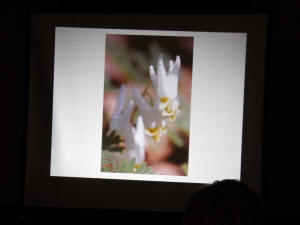
The Dutchman’s breeches is a small white and yellow
flower that looks like a pair of pants. The flower is pollinated by
the queen bumble bee and its seeds are spread by ants. Lee included
the reading of a poem that likened the flower to the “panties” of
the fairies.

The flower is toxic to animals and can have a drug like effect on
people. Therefore, the plant is often also referred to as “Stagger
Weed” as it impacts the body in a fashion similar to morphine.
Folklore also says that the reason butter is yellow is because the
cows ate the buttercups. It is also said that when the flower is
held to the chin, if the yellow of the boom transfers to the skin
that is an indication that the person loves to eat butter.
Buttercups
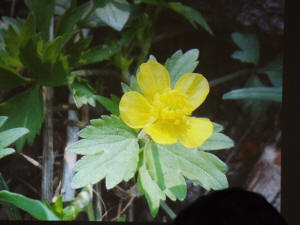
The buttercup is also sometimes called “fair gold”
for its color. It has “itchy greens” and a bitter taste. The little
plants will grow just about anywhere. They are often related to
personality traits such as humility, neatness and child-likeness.
May apples
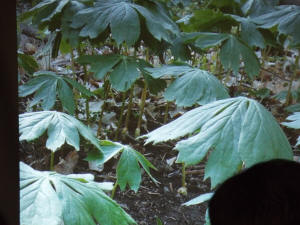
May apples pop up in the spring and bloom for a week
or two but remain green all summer long. The plant is both edible
and poisonous. The fruit that is produced in the early fall is
edible and the size of a small lemon. The greens however are
poisonous.
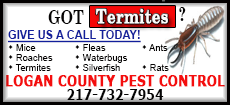
The greens of the plant have also been harvested for sale to
pharmaceutical use as it will induce vomiting and also has laxative
values.
Purple Trillium
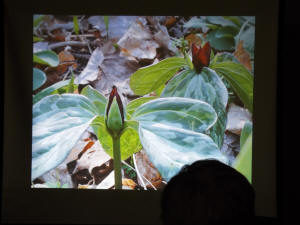
Purple Trillium is on the endanger plant species list
in Illinois. This plant blooms from mid-April to May and lives on
Elkhart Hill.
Spring beauty
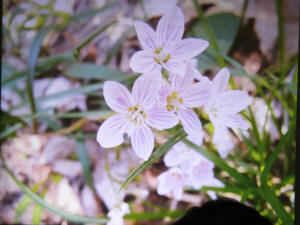
The spring beauty is a white flower with pink
variegations or stripes in the pedals that make it look pink. This
is also an interesting plant in that the stamens are pink.
Blood root
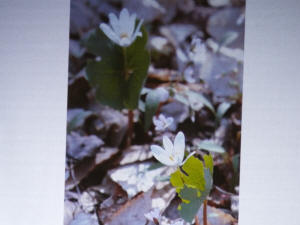
Blood root is a white poppy like flower that gets its
name for the deep red sap that comes from the root of the plant. It
was commonly used as Indian face paint in olden days. The plant also
has many medicinal uses including as cough medicine and treatment
for ulcers, skin infections and ring worm. The plant also has value
as an insecticide.
Yellow Woodland Violet
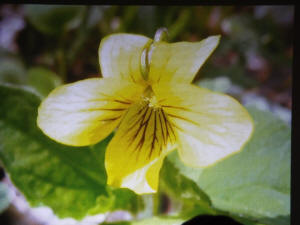
This flower grows on Elkhart Hill and it is the state
flower of Illinois, New Jersey, Rhode Island and Wisconsin.
[to top of second column] |

The plant is used for perfume, and has been the
subject of poems.
The plants bloom from April to Mid-May
Sweet William

Sweet William and the Black-eyed Susan are a
“couple.”
A folk story about the two is displayed in a poem about Susan
searching for her beloved William. “Tell me true, is my Sweet
William there with you?”
Sweet William is also related to the personality trait gallantry.
Wild ginger
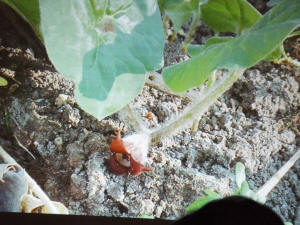
Lee read a story about a young girl and her Aunt Beth
who made their way up the hill looking for the wild ginger. The trip
was made in the spring when the plant was starting out. However, the
roots could not be harvested until fall, so the pair would stake the
plants for a return in the fall to dig up the roots.
The story went on to talk about the anticipation of the little girl
for the day the root would be dug up and the house would fill with
the smell of gingerbread made from the root, how the little child’s
mouth would water in anticipation and she would eat much more than
she should have.
The story also noted the fine details of the plant, such as the fact
that the blooms come out under the leaves, staying close to the
ground. The blooms according to Aunt Beth are on the ground because
they are pollinated by ants.
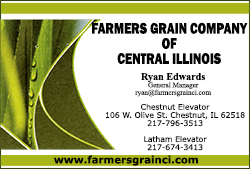
Blue bells
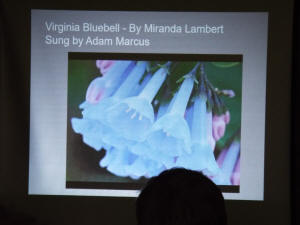
Lee noted that of all the wildflowers, blue bells are
her favorite. These lovely flowers with their heads hanging down
grow in masses on Elkhart Hill creating a sea of blue in a woodland
landscape that is awe inspiring.
Folklore says that it is unlucky to step on a blue bell, pick or
bring it in the house. The plants are to remain wild and free on the
hillside.
Lee played a song – Virginia blue bell, written by Miranda Lambert
and sang by Adam Marcus. The song speaks to the head hanging down
the “pretty little thing…” and encourages “sometimes you’ve got to
look up and let the world see the beauty you are made of.”
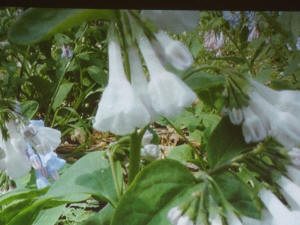
In addition to the blue blue bell, Lee
explained that there are blue bells that for ease of explanation are
albino. She noted that these are the rare clumps that lack
pigmentation, so they bloom white. Lee said one in 10,000 plants
lack this pigmentation, and Elkhart Hill has the albino blue bells
growing in its woodland.
There are many, many wildflowers that grow indigenously in Illinois
and on Elkhart Hill. This article represents only a slice of what
Lee presented and her presentation also was a slice of what can be
found in nature here in Logan County.
Lee encouraged her guests to get out this spring and enjoy the
wildflowers, especially those on Elkhart Hill.
Wildflower walks begin this Saturday and are scheduled for the next
four Saturdays. Guided tours are given at 10 a.m. and 2 p.m. There
is a fee for the tours and a reduced price for children ages eight
to 12 years old. For those who work up an appetite a lunch time
special is also offered at the Wild Hare Café.

On April 27th in addition to the scheduled wildflower walks there
will be a special bird walk at 6 a.m. and again at 4 p.m.
The weekly walks are sponsored by the Elkhart Historical Society and
the fees paid go to support the society. Anyone who is interested in
reserving a spot at one of the walks is encouraged to call
217-947-2238 for further details and registration information.
For those attending the walks, the starting point is the Country
Bumpkin, 103 Governor Oglesby Street in Elkhart. Please arrive at
least 20 minutes before the scheduled tour.
[Nila Smith] |